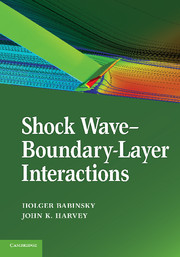Book contents
- Frontmatter
- Brief Contents
- Contents
- Contributors
- 1 Introduction
- 2 Physical Introduction
- 3 Transonic Shock Wave???Boundary-Layer Interactions
- 4 Ideal-Gas Shock Wave???Turbulent Boundary-Layer Interactions (STBLIs) in Supersonic Flows and Their Modeling: Two-Dimensional Interactions
- 5 Ideal-Gas Shock Wave???Turbulent Boundary-Layer Interactions in Supersonic Flows and Their Modeling: Three-Dimensional Interactions
- 6 Experimental Studies of Shock Wave???Boundary-Layer Interactions in Hypersonic Flows
- 7 Numerical Simulation of Hypersonic Shock Wave???Boundary-Layer Interactions
- 8 Shock Wave???Boundary-Layer Interactions Occurring in Hypersonic Flows in the Upper Atmosphere
- 9 Shock-Wave Unsteadiness in Turbulent Shock Boundary-Layer Interactions
- 10 Analytical Treatment of Shock Wave???Boundary-Layer Interactions
- Index
- References
7 - Numerical Simulation of Hypersonic Shock Wave???Boundary-Layer Interactions
Published online by Cambridge University Press: 05 June 2012
- Frontmatter
- Brief Contents
- Contents
- Contributors
- 1 Introduction
- 2 Physical Introduction
- 3 Transonic Shock Wave???Boundary-Layer Interactions
- 4 Ideal-Gas Shock Wave???Turbulent Boundary-Layer Interactions (STBLIs) in Supersonic Flows and Their Modeling: Two-Dimensional Interactions
- 5 Ideal-Gas Shock Wave???Turbulent Boundary-Layer Interactions in Supersonic Flows and Their Modeling: Three-Dimensional Interactions
- 6 Experimental Studies of Shock Wave???Boundary-Layer Interactions in Hypersonic Flows
- 7 Numerical Simulation of Hypersonic Shock Wave???Boundary-Layer Interactions
- 8 Shock Wave???Boundary-Layer Interactions Occurring in Hypersonic Flows in the Upper Atmosphere
- 9 Shock-Wave Unsteadiness in Turbulent Shock Boundary-Layer Interactions
- 10 Analytical Treatment of Shock Wave???Boundary-Layer Interactions
- Index
- References
Summary
Introduction
Hypersonic flows are synonymous with high-Mach number flows and therefore are characterized by very strong shock waves. Every hypersonic vehicle has a bow shock wave in front of it, which bounds the flow around the vehicle. On the windward side of a vehicle, the bow shock usually is aligned closely with the vehicle surface, and the distance between the surface and the shock wave is usually small relative to the characteristic dimension of the vehicle. Thus, this shock-layer region is usually quite thin. Hypersonic vehicles tend to fly at high altitudes so that convective heating levels can be managed. Thus, the characteristic Reynolds numbers tend to be low and boundary layers are usually thick. In addition, shear heating in hypersonic boundary layers increases the temperature and viscosity, which also increases the thickness. The low Reynolds number and the relative stability of hypersonic boundary layers mean that many practical hypersonic flows are laminar or transitional. If the flow is turbulent, it is often only marginally turbulent. Therefore, hypersonic flows are particularly susceptible to shock wave–boundary-layer interactions (SBLIs).
Information
- Type
- Chapter
- Information
- Shock Wave-Boundary-Layer Interactions , pp. 314 - 335Publisher: Cambridge University PressPrint publication year: 2011
References
Accessibility standard: Unknown
Why this information is here
This section outlines the accessibility features of this content - including support for screen readers, full keyboard navigation and high-contrast display options. This may not be relevant for you.Accessibility Information
- 4
- Cited by
